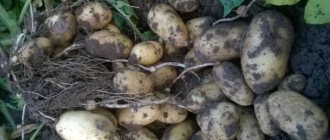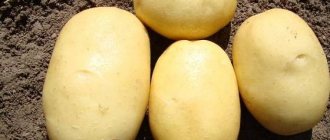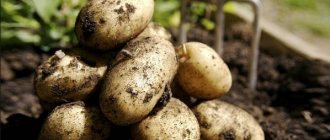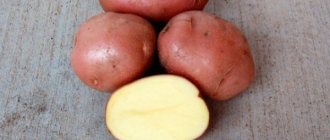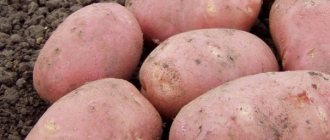Potato Manifest. Even before the onset of the new season, summer residents and gardeners begin to plan future plantings and are actively interested in new varieties of crops. No one wants to lose their harvest due to pests, drought, long rains or any other natural surprises. Particular attention is paid to potatoes, because they are called second bread for a reason.
Most farmers annually look for planting new varieties of this crop that are resistant to diseases and pests, unpretentious to growing conditions and at the same time high-yielding. Thanks to modern selection, this task is quite feasible. In recent years, the greatest interest has been generated by the potato variety Manifesto, bred in Belarus, which meets all of the above requirements. It entered the State Register of the Russian Federation quite recently, only in 2014, but today these potatoes are successfully grown in many regions of our country.
Description of the potato variety Manifesto
The Manifest potato variety was bred by Belarusian breeders, but in a very short period it became popular not only in Belarus, but also in neighboring countries.
There are no special notes in the appearance of bushes of this variety. They are erect and grow up to 50 cm. The leaves are medium in size, fully open and with slight serrations along the edges. Their color is rich green with an emerald tint, and their surface is glossy.
Flowering occurs quite quickly, disappearing almost completely after 7-10 days. The flowers are lilac in color, their inner side is brighter.
According to the ripening of tubers, this variety is classified as medium-late. From the moment of planting and the appearance of the first shoots until full ripening, it takes from 90 to 110 days, depending on the growing conditions.
Root crops are large in size, often reaching up to 150 g, and the weight of medium-sized tubers varies from 90 to 120 g. Their shape is oblong with rounded edges. The peel is dense, but easy to peel. Has small eyes. Its color is pinkish, and its flesh is yellow with a slight amber tint. The starch content in one tuber can reach up to 15%. The digestibility of the fruit is average.
Taste qualities of potatoes
The characteristics of the Manifest potato variety are confirmed by numerous reviews. In addition, the vegetable crop of this variety is valued not only because of its high and large-fruited harvest, but also for its excellent table and taste qualities.
Since the Manifest potato is a red variety, its tubers contain a lot of antioxidants, which makes their flesh very tender. They are also a good source of carbohydrates and contain vitamins C, B6, PP and various minerals (iron, potassium, phosphorus, manganese, copper and magnesium).
The starch content varies from 12 to 15%, which indicates average boilability. A lower percentage of starch content makes the fruits poorly cooked, while a higher percentage indicates a strong disintegration of the pulp during cooking.
Such taste and table characteristics of the Manifesto potato indicate its full suitability for preparing a wide variety of dishes, ranging from mashed potatoes to boiling in their jackets.
Advantages
No significant deficiencies were identified in the Manifesto variety. But there are a large number of advantages that distinguish this potato variety from its competitors. The plant has good immunity to all common diseases. However, you should still not forget about preventive measures.
Tubers have a universal purpose and can be used for:
- preparing first courses, chips, casseroles, etc.;
- obtaining natural potato starch;
- treatment of certain diseases using traditional medicine methods;
- cosmetic purposes.
Manifesto potatoes have a universal purpose and are distinguished by excellent taste.
A very valuable property of this variety is excellent transportability and suitability for long-term storage. Thanks to this quality, the tubers are exported abroad. In addition, the early potato variety Manifest contains a huge amount of vitamins and microelements. Potassium and B vitamins bring invaluable benefits to the human body.
As you can see, Manifest potatoes have enormous advantages over competing varieties. Even a novice gardener can grow it on his own plot, and you can buy planting material either in a specialized gardening store or order it online.
Pros and cons of the Manifest variety
It’s not for nothing that the Manifesto potato is practically in the top position of choice among consumers, because it has many advantages:
- good taste in combination with average digestibility allows the fruits to be used for preparing various dishes;
- content of useful microelements and vitamins;
- root vegetables have a good appearance;
- high productivity;
- good shelf life (95%);
- transportability.
The disadvantages include:
- with improper planting and care, the crop becomes significantly smaller;
- high probability of being affected by potato moth.
Planting and caring for potatoes Manifesto
The speed of ripening, as well as the quality of the future Manifest potato harvest, directly depend on timely planting and proper care during the growing season. It is also necessary to take into account the soil and climatic conditions for planting this root crop.
Selection and preparation of a landing site
It is advisable to allocate a plot of land with light, breathable soil and an average level of acidity for planting the Manifest potato variety.
Preparing the soil for planting this crop should begin in the fall. During this period, it is necessary to carry out work to fertilize the soil. To do this, approximately 40-60 kg of organic mixture (humus, peat or compost) is taken per 1 hectare of land. The soil is dug up and fertilizers are applied at the same time.
After winter, the soil should also be fertilized. It is best to use inorganic fertilizer - nitroammophoska at the rate of 4 kg per 1 hundred square meters.
Preparation of planting material
If you plan to plant Manifest potatoes as tubers, they should be prepared a month before planting. Sorting and selection of root crops is carried out. It is advisable to take them of the same size with a diameter of 5-6 cm. They should be without signs of disease and without deformation. Then they are placed in boxes, laid out in 3-4 layers, and left there for germination. Boxes with planting material should be placed in a well-lit and warm place.
Immediately before planting, it is necessary to select planting tubers again. Among the sprouted root vegetables, it is best to select only those whose sprouts are the densest. But with thin and single sprouts, it is better not to use planting material.
Advice! To increase productivity, it is advisable to spray the tubers with solutions of copper sulfate and boric acid before planting. They provide resistance to fungal diseases and rhizoctonia.
When planting Manifest potato seeds, germination is first performed. To do this, 2 days before planting in a container, the seed material is transferred to cool water. Place in a refrigerator with a temperature not lower than 1C0, this procedure is necessary for hardening.
Then the container for germinating seeds is filled with soil at the rate of 1 part soil to 4 parts peat and watered well. The seeds are placed in prepared soil in rows at intervals of 10 cm, sprinkled with sand on top to a depth of no more than 0.5 cm. Lightly tamp the soil and cover with film.
The seeds should be periodically watered and ventilated by opening the film for 30 minutes.
Although germination of seeds is a labor-intensive process, it is a good prevention of various diseases of root crops, and also promotes faster ripening.
Landing rules
Planting is usually done in the first ten days of May. And it must be carried out in sufficiently warmed soil so that its temperature is not lower than +8C0.
Important! Planting dates can vary significantly depending on the region; it is best to focus on warming up the soil.
There are several ways to plant root crops. For Manifest potatoes, it is best to use ridge technology. This method guarantees early emergence and maintenance of loose soil structure.
The planting technique itself consists of 3 main stages:
- Loosening the soil and making furrows up to 8-10 cm deep. The distance between furrows should be at least 70 cm.
- Seed tubers are placed in the prepared furrows at a distance of at least 30 cm (this should be done carefully so as not to damage the sprouts). Fill the furrows with loose soil, without tamping, and form ridges 10-12 cm in height.
- Then, once a week, increase the height of the ridge until it reaches a height of up to 30 cm.
Watering and fertilizing
Since, according to the description, Manifesto potatoes are large-fruited, in order to achieve such a yield, fertilizing and watering should still be done.
Plants need to be watered at least 2 or 3 times during budding. It is recommended to use rain watering method. Thus, the liquid is distributed evenly over the area.
After watering, hilling should be done to restore the ridges and saturate the soil with oxygen.
If the soil was well fertilized before planting, then it is enough to fertilize only once during cultivation. Fertilizing is done when the tops grow up to 10 cm in length. The mixture is prepared from manure, take 1 kg and dilute it with 10 liters of water, and also add a tablespoon of superphosphate. Apply this mixture only at the root; the solution should not get on the tops.
Important! It is not recommended to use nitrogen as a fertilizer for potatoes, as it will promote the growth of tops and not root crops.
Loosening and weeding
Loosening the soil in a plot with Manifest potatoes is a very important procedure. It is carried out using a rake even before the emergence of shoots. You should also loosen the soil after rain and watering.
After emergence of seedlings, loosening the soil is necessary, since the formation of root crops is accelerated in aerated soil.
Don't delay weeding. An area with potato plantings should be weeded 2 times per season:
- When the shoots reach 2-3 cm (about 3-4 weeks after planting).
- When the tops reach 30 cm.
Advice! If weeds appear abundantly and faster than the potatoes sprout, you should not wait for sprouts to appear; it is better to weed as the weeds grow.
Hilling
Hilling up potatoes is also the most important procedure, like loosening and weeding. They are often combined. This soil treatment allows you to maintain the tops, enriches the soil with oxygen and additionally prevents the growth of weeds.
Hilling is carried out between the rows, raking the soil to the potato stems. At the same time, a thorough inspection of the tops should be carried out and, if necessary, dried and deformed leaves should be removed.
It is advisable to perform this procedure after 10-15 days.
Feeding
For the first fertilizing, it is good to use rotted manure or diluted bird droppings. This is very important if fertilizers were not applied when digging or planting tubers. To do this, their aqueous solution is infused for several days in a ratio of 1 to 15, and then after watering, about 1 liter of the solution is poured under one bush.
Before hilling, it is useful to fertilize with urea (1 tablespoon per 10-liter bucket) or half-diluted mullein (dung).
During the budding period, you will need to fertilize with potassium - dilute 1 tbsp in 10 liters. a spoonful of potassium sulfate and 3 tbsp. spoons of ash. Before flowering, foliar feeding, for example, urea (300 g/10 l), will also be useful. During flowering, you need to feed with phosphorus - put 2 tbsp per 10 liters. spoons of superphosphate and a little manure (litter).
spoon per 10-liter bucket) or half-diluted mullein (dung).
Diseases and pests
A good harvest depends not only on proper care, but also on prevention against diseases and pests.
The most common disease that can significantly reduce the amount of harvest is late blight. For prevention, copper sulfate and lime are used, which are used to irrigate the soil before planting root crops.
Among the common pests that most often destroy the potato crop are the potato moth and the Colorado potato beetle. Biological and chemical drugs are most often used against them, but they need to be used only before the first ovaries appear.
“Bitoxibacillin”, “Dendrobacillin” and “Liptocid” help well against potato moth. And insecticides are used against the Colorado potato beetle.
Features of cultivation
The growth time and quality of the crop depend on timely planting and compliance with agricultural practices for growing the crop.
Preparing for landing
Tubers begin to be prepared 20–25 days before planting. First, healthy specimens are selected without damage, approximately the same size of 5-6 cm. The vegetables are placed in a spacious container in 3 layers. The container is placed in a warm, bright place and left for the tubers to germinate. After the sprouts appear, the planting material is re-inspected.
Important ! For planting, leave the tubers on which several strong, dense sprouts have formed.
Vegetables are treated with a weak blue solution of copper sulfate or a solution of boric acid to prevent fungal infections.
The crop is also planted with seeds. To do this, they are first germinated and then hardened in the refrigerator. After this, they are planted in containers with soil (1 part turf soil and 3 parts peat). The seeds are placed in rows at intervals of 8-9 cm, and a thin layer of sand is poured on top. The soil is carefully watered and covered with a transparent film. Ventilate the container regularly.
Soil requirements
The Manifest variety grows well both in open ground and in greenhouse conditions, on light, breathable soil with an average level of acidity. Chernozem, sierozem, leached chernozem, and chestnut soil are ideal. The soil is prepared after the next harvest. When digging, add compost, peat, and humus. In spring, fertilize with complex products containing nitrogen, potassium, and phosphorus in equal quantities.
Planting dates and scheme
Planting takes place in mid-May. The prepared material is planted only in warm soil, when it warms up to +8...+10°C.
Attention ! Planting dates vary depending on the climatic conditions of the region.
For the Manifesto, breeder-developers recommend ridge technology for planting tubers. It consists of several stages:
- When loosening the soil, make furrows 9-10 cm deep. Keep 60-70 cm between them.
- The sprouted tubers are carefully placed in the grooves, leaving a gap of 28–30 cm between the planting material. This is done carefully so as not to break off the sprouts. The furrows are sprinkled with loose soil on top, forming ridges 13–15 cm in height.
- Gradually add soil to the ridge every week until it reaches 28–30 cm.
This growing technology promotes earlier emergence of seedlings, 12–14 days earlier than with conventional planting. When using this method, the soil always remains loose and breathable. Yields increase by 30–40%.
Nuances of care
Before planting, the soil is aerated to enrich it with oxygen. During the growing period, the soil is mulched and regularly loosened.
For free growth of potatoes and movement during crop care, leave at least 60–70 cm between the bushes.
Watering mode
The culture does not require frequent watering. The first time it is moistened during planting of sprouted tubers, the second time - when the tops stretch to 13–15 cm. The next watering is carried out during flowering. During this period, drip irrigation is well suited to distribute water evenly throughout the beds. After flowering ends, the crop is moistened for the last time.
Important! Experienced gardeners do not recommend watering after the crop has flowered: this increases the risk of late blight.
After each irrigation, hilling is carried out so that the ridges do not sink and for better aeration of the soil.
Feeding
When planting tubers, add wood ash (1 tablespoon each) to the holes. It contains potassium, phosphorus, calcium, iron, magnesium, sulfur, zinc, and protects plants from blackleg.
When the tops grow to 10–12 cm, apply a product consisting of mineral and organic fertilizers. A mixture of 1 liter of manure diluted in a bucket of water with the addition of 15 g of superphosphate gives a good result. The nutritional composition is applied at the root.
It is undesirable to use nitrogen fertilizers to feed potatoes: they promote rapid growth of tops to the detriment of tubers.
Weeding and hilling
Potatoes must be weeded. For the first time when seedlings emerge, 20 days after planting the tubers. When weeds grow rapidly, do not wait for young tops to appear, but remove the weeds immediately. The second weeding is carried out when the tops reach 30 cm in height.
Important! During weeding, the soil is loosened for soil aeration and better growth of tubers. The soil is also loosened after watering or rain.
Hilling is carried out every 10 days, combined with weeding and loosening. Using a hoe, they rake the soil up to the tops of the tops, keeping it upright. At the same time, inspect the bushes and remove damaged and dry leaves. The procedure helps remove weeds and supplies the soil with oxygen.
Disease and pest control
Potatoes often suffer from late blight. The disease affects the tops, then spreads to the tubers. Small dark brown spots appear on the leaves and stems and quickly enlarge. As a result, the leaves wither, turn black and dry out.
At the first signs of late blight, the bushes are treated with substances containing copper: copper sulfate solution, Bordeaux mixture.
For prevention, lime is used, a solution of which is sprayed on the ground before planting the crop.
Common pests that destroy vegetables: potato moth and Colorado potato beetle. Biological and chemical agents are used to combat them.
Attention ! Chemicals are not used when ovaries appear.
Potato moth multiplies quickly. Signs of its appearance are cobwebs and drying leaves. It is difficult to get rid of the insect; the larvae can destroy a significant part of the crop. Lepidocide and Dendrobacillin are used in pest control. Treatment is carried out until the ovaries appear.
Insecticides “Matador” and “Proteus” help get rid of the Colorado potato beetle.
Harvesting and storage
Harvesting should begin only after the tops have dried from 40 to 60%. Before digging up the crop, cut off the stems 2 weeks before. This procedure allows the root vegetables to form a denser layer of peel.
You should not delay the collection time, since if root crops remain in the ground for a longer period, their storage is significantly reduced. They will begin to germinate much earlier.
After digging, the potatoes should be dried in a warm, bright room. Then it is packaged, separating large root crops from small ones, and tubers are also selected for planting next year.

